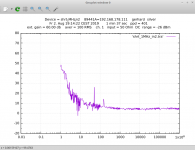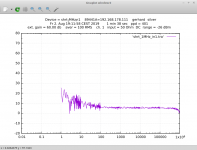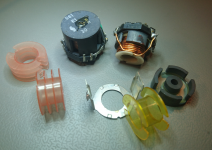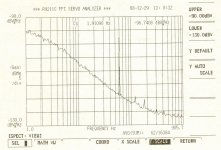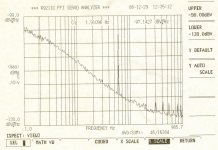Even a very large & $$$ transformer would, at best, achieve 1.5dB NF so this is a 21st century real life application
How do you support this statement? Even if this were true a 10 mOhm ribbon would yield 0.02nV or so. BTW have you ever seen the 0.06nV transformer feedback amp on Mr. Hill's site? I think it can do no harm to the ribbon either.
Attached. High-frequency response is IMO superb, LF could be better, but it's only a matter of replacing a few caps (if one really thinks it's worth of).
Yes, this is as good as a USB sound card could be, I've never seen anything better (although it could exist, I don't claim I've seen them all). All for 150 of your pounds.
Many thanks for doing this.
- PSRR for both is at levels in the 60 dB range from 10Hz up to a few kHz
Be aware that all other parts (resistors and capacitors) are absolutely identical in LTSpice.
Be also aware that the simmed 60dB PSRR will never be reached in reality as especially the capacitors are not identical but can have up to 20% or more tolerance. If simmed with capacitors with 20% difference in value, PSRR will drop to a level of 30 to 40 dB. Especially the output capacitors have a very high influence - any difference here reduces the 'common mode rejection' and creates some differential signals at the output which get not suppressed.
Even a very large & $$$ transformer would, at best, achieve 1.5dB NF so this is a 21st century real life application
Revealed as a fraud by Guru Wurcer!!How do you support this statement? Even if this were true a 10 mOhm ribbon would yield 0.02nV or so. BTW have you ever seen the 0.06nV transformer feedback amp on Mr. Hill's site? I think it can do no harm to the ribbon either.
I should rephrase that. My best effort was 1.7dB NF in my Calrec days with a large Lundhal or Sowter transformer & 5534 for a mike preamp.
Dis Millenium, I went through the same exercise with the huge & hugely $$$ S&B 103 core and 5534 but couldn't get the numbers to better 1.5dB. This was with a 5534. AD797 would be slightly worse cos the EVIL Ib cancelling unless da circuit took this into account (matched Z on both + & - pins)
In theory, a better transformer solution would be to use an even higher ratio and one of da uber FET i/p OPAs with their zillion ohm Rni (maybe just a FET) as a follower .. but I have no practical experience of these beasts or this configuration. I suggested it to Les Watts and I think he does this on his commercial active ribbon.
Eric Benjamin sent me a scan of the H&H 2 yrs ago which made the mike designer in me cringe but I no longer have this. I'll have to ask for another copy to see if I'm pontificating from the wrong orifice (as is becoming more common in my old age
Revealed as a fraud by Guru Wurcer!!
I should rephrase that. My best effort was 1.7dB NF in my Calrec days with a large Lundhal or Sowter transformer & 5534 for a mike preamp.
Yes, no need to be defensive but cobbling things together and swapping devices to see how they perform is not fundamental design. Graeme Cohen was somewhat defensive when folks pointed out that Bob Demrow's circuit was almost exactly the same.
Be also aware that the simmed 60dB PSRR will never be reached in reality as especially the capacitors are not identical but can have up to 20% or more tolerance. If simmed with capacitors with 20% difference in value, PSRR will drop to a level of 30 to 40 dB. Especially the output capacitors have a very high influence - any difference here reduces the 'common mode rejection' and creates some differential signals at the output which get not suppressed.
Did you use ideal caps or models that included ESR? The powered version of the Duraglit offers very good PSRR performance, but this drops off rapidly once ESR in the rail decoupling caps is included. I therefore recommend on the powered versions that an opamp buffer/PSU like those shown in the back of the MC HA presentation are used. PSRR of > 70 dB is achievable, and even better if these follow on from say a LM7815 type reg (typical wideband noise of these is around 150 uV at 15V out - so considerable y better than a 317 type reg.
Ah, I had always assumed that Cohen started with the Demrow input then added the cross-coupled output to make it balanced in and out.
I was talking more about the noise issue. To me picking different transistors and biasing them at more current is a trivial exercise.
I thought you were commenting on my miserable 1.5dB NF transformer efforts.Yes, no need to be defensive but cobbling things together and swapping devices to see how they perform is not fundamental design.
I was just adding a datapoint. A transformer solution (which must include the accompanying amp for completeness) would need an even bigger core than the $1750 S&B 103 to equal the simplest Duraglit solution .. unless some new, even more $$$ & Unobtainium material, materializes. This is with squeezing the LF response/overload/noise compromise inherent in a transformer to the limit towards LN.
There is a caveat to this. Very high Z transformer windings have HF problems cos leakage & other stuff. Lundahl refuse to do transformer windings above 20K (IIRC) cos they reckon the HF would not then meet their high standards. Les Watts was recounting his experiences with the transformer designer/maker for his active ribbon.In theory, a better transformer solution would be to use an even higher ratio and one of da uber FET i/p OPAs with their zillion ohm Rni (maybe just a FET) as a follower .. but I have no practical experience of these beasts or this configuration.
____________________________
I should really dig up Great Guru Baxandall's Last words on LN design. Apart from being a very clear explanation of the issues, it also has worked examples on LN Transformer Design. The knowledge for this last is rapidly becoming truly Unobtainium
IIRC, he also uses the Rni / Rnv approach which doesn't seem to find favour these days ... except for those who learnt LN design at his feet.
Richard Lee's original circuit
Just saw this thread as I am logging into DIY forum after a few months gap. I built the orginal circuit of Mr Lee after his circuit idea was published in Wireless World around mid '80s ( I think!) using 2n4401 and 4403 as they were the only ones available in Mumbai at that time. Remember trying it at my friends place in his expensive system with a supex MC in place of his step up device. Wow, what a difference. Fast forward 3 decades plus to two years ago. Breadboarded this device with a matched ZTX851/ 951 combo as it was supposed to have lowest rbb. I was using rechargeable NiMH batteries. Great sound but something was bothering me. On a whim I used a charged supercap (Maxwell, 350F, 2.5V) and disconnected the battery. The improvement was superb. So for the quietest supply for this circuit with 5ma needed, try a supercap. You can use the rechargeable battery ( 2 in series) to top up to 2.5V when not in use through a simple double pole switch. Only down side, size of the cap compared to the tiny perf board with the circuit.
My 2 cents worth.
A big thanks to Richard for this amazing but simple circuit. Listening to LPs with this step up is a revelation.
Ravi
Just saw this thread as I am logging into DIY forum after a few months gap. I built the orginal circuit of Mr Lee after his circuit idea was published in Wireless World around mid '80s ( I think!) using 2n4401 and 4403 as they were the only ones available in Mumbai at that time. Remember trying it at my friends place in his expensive system with a supex MC in place of his step up device. Wow, what a difference. Fast forward 3 decades plus to two years ago. Breadboarded this device with a matched ZTX851/ 951 combo as it was supposed to have lowest rbb. I was using rechargeable NiMH batteries. Great sound but something was bothering me. On a whim I used a charged supercap (Maxwell, 350F, 2.5V) and disconnected the battery. The improvement was superb. So for the quietest supply for this circuit with 5ma needed, try a supercap. You can use the rechargeable battery ( 2 in series) to top up to 2.5V when not in use through a simple double pole switch. Only down side, size of the cap compared to the tiny perf board with the circuit.
My 2 cents worth.
A big thanks to Richard for this amazing but simple circuit. Listening to LPs with this step up is a revelation.
Ravi
Did you use ideal caps or models that included ESR? The powered version of the Duraglit offers very good PSRR performance, but this drops off rapidly once ESR in the rail decoupling caps is included. I therefore recommend on the powered versions that an opamp buffer/PSU like those shown in the back of the MC HA presentation are used. PSRR of > 70 dB is achievable, and even better if these follow on from say a LM7815 type reg (typical wideband noise of these is around 150 uV at 15V out - so considerable y better than a 317 type reg.
Caps were simmed with some ESR (60 mOhm). But for the floating supply, ESR per se is not important. What counts is symmetry. Every difference in ESR or capacitance makes things worse.
If using a grounded dual PS, PSRR of the amp itself is only 6dB. In this case good PSRR can only be achieved with good PS rail filtering. ESR of filter caps will limit the max. obtainable noise attenuation.
One needs either selection of caps with smallest ESR, cascade filter stages, go with higher supply voltages to allow more drop at a higher series impedance before the caps or go with active buffering (e.g. cap multiplier)
I was just adding a datapoint. A transformer solution (which must include the accompanying amp for completeness) would need an even bigger core than the $1750 S&B 103 to equal the simplest Duraglit solution .. unless some new, even more $$$ & Unobtainium material, materializes. This is with squeezing the LF response/overload/noise compromise inherent in a transformer to the limit towards LN.
There is a caveat to this. Very high Z transformer windings have HF problems cos leakage & other stuff. Lundahl refuse to do transformer windings above 20K (IIRC) cos they reckon the HF would not then meet their high standards. Les Watts was recounting his experiences with the transformer designer/maker for his active ribbon.
____________________________
I should really dig up Great Guru Baxandall's Last words on LN design. Apart from being a very clear explanation of the issues, it also has worked examples on LN Transformer Design. The knowledge for this last is rapidly becoming truly UnobtainiumThe only thing missing is HiZ condensor mike stuff for which you have to see his 1967 Wireless World article (in MicBuilders) or Guru Wurcer's LN articles in Linear Audio.
Methinks Scott was talking about the Lepaisant design. We discussed that years ago in sci.electronics.design.
< https://pdfs.semanticscholar.org/49b5/63335faea2836e65c6dee411d5c8b04d5a3e.pdf >
The Siemens N48 cores are as common as it gets. The ex Siemens ferrite division is now TDK-EPCOS.
There is also news from the electrolytics front.
The better cap is the DK 1189-1056-nd, already used above.
The one with the worse 1/f is DigiKey P15324CT-ND, although it is mechanically bigger and has "better" data. It was meant to be an improvement :-(
It seems to be just a matter of luck. At least, they are not as bad as the organic polymer ones.
I have not yet changed them back and tested if this is the only reason because the 2 amplifiers have a lot of wiring around them and I would not like to rip it apart too often.
I have Syn08's caps on my list for the next order, along with some ECP2037 / EPC2038 GaN FETs to be used as switches in my chopper amp. If they don't kill the charge injection, then I don't know what would.
Attachments
I was talking more about the noise issue. To me picking different transistors and biasing them at more current is a trivial exercise.
Ah yes, Agreed.
@Gerhard. How hard is winding one of those pot cores?
@Gerhard. How hard is winding one of those pot cores?
Folks have been fascinated with paralleling devices forever. In fact we won a best design idea ($150) from EDN (>25 yr. ago) for stacking two instrumentation amplifiers for 3dB noise improvement.
Nothing stopping you from paralleling the input side of two or more SUT's and seriesing the output sides the same way. Think of the possibilities.
BTW you will find the AD845's in the article unobtainium but there are plenty of choices for the IC's today.
Last edited:
I have Syn08's caps on my list for the next order, along with some ECP2037 / EPC2038 GaN FETs to be used as switches in my chopper amp. If they don't kill the charge injection, then I don't know what would.
I did not measure anything under 10Hz, so those Al polymer electrolytics may have some 1/f noise there, I don't know.
@Gerhard. How hard is winding one of those pot cores?
Easy. But at 300 turns boring.
There is a coil former made from plastic, you just wind the wire on it and then clip everything together.
The empty coil formers in the picture are not made by Siemens, they
are former GDR production.
This Siemens core is K1 material (3-15 MHz) and smaller, with a Q of 400-500
ideal for a shortwave preselector filter.
N48 material must be 50 years old, there must be newer ones with higher ur and less losses.
Lepaysant e.a. noted that they increased ur by machining; probably they had a type
with an air gap in the middle of the core and they removed that. If one is careful, sand paper should work. Or bying a core w/o air gap.
Attachments
3 chamber coil formers are popular. When you have a core with an air gap
in the middle peg, there will be flux in the air there. With a 3 chamber coil
former, one can avoid metal there either completely or upholster with
plastic foil or paper to avoid eddy currents in the copper that would spoil Q.
in the middle peg, there will be flux in the air there. With a 3 chamber coil
former, one can avoid metal there either completely or upholster with
plastic foil or paper to avoid eddy currents in the copper that would spoil Q.
Methinks Scott was talking about the Lepaisant design. We discussed that years ago in sci.electronics.design.
< https://pdfs.semanticscholar.org/49b5/63335faea2836e65c6dee411d5c8b04d5a3e.pdf >
The Siemens N48 cores are as common as it gets. The ex Siemens ferrite division is now TDK-EPCOS.
There is also news from the electrolytics front.
The better cap is the DK 1189-1056-nd, already used above.
The one with the worse 1/f is DigiKey P15324CT-ND, although it is mechanically bigger and has "better" data. It was meant to be an improvement :-(
It seems to be just a matter of luck. At least, they are not as bad as the organic polymer ones.
I have not yet changed them back and tested if this is the only reason because the 2 amplifiers have a lot of wiring around them and I would not like to rip it apart too often.
I have Syn08's caps on my list for the next order, along with some ECP2037 / EPC2038 GaN FETs to be used as switches in my chopper amp. If they don't kill the charge injection, then I don't know what would.
This is for the 493-3103-ND 3900uF/2.5V aluminum polymer, from 1Hz to 1KHz. First is measuring preamp input shorted, second is with the input shorted by the cap. No noise difference that I can tell. The 1/f noise drops a little under 2Hz since the measurement preamp has the LF pole somewhere around 1Hz. Measurement preamp has 60dB gain (59.88dB, actually), a noise of 0.4nV/rtHz flat @ 5KHz and above, and a bandwidth of about 400KHz, it's BF862 JFET based, self made.
Attachments
- Home
- Source & Line
- Analogue Source
- Richard Lee's Ultra low Noise MC Head Amp
